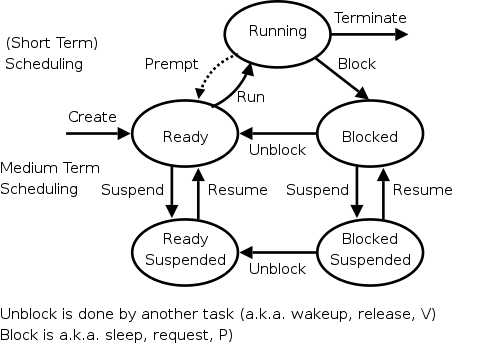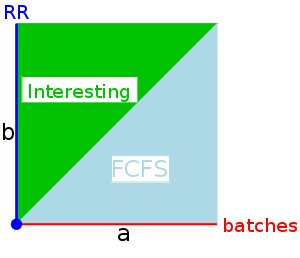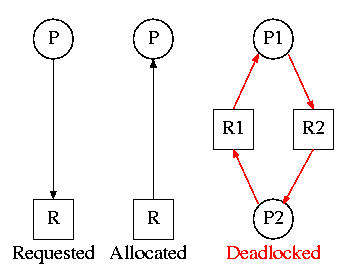
Start Lecture #5; Skipped during Lecture #4
A race condition occurs when two (or more) processes are about to perform some action. Depending on the exact timing, one or other goes first. If one of the processes goes first, everything works correctly, but if another one goes first, an error, possibly fatal, occurs.
Imagine two processes both accessing x, which is initially 10.
We must prevent interleaving sections of code that need to be atomic with respect to each other. That is, the conflicting sections need mutual exclusion. If process A is executing its critical section, it excludes process B from executing its critical section. Conversely if process B is executing is critical section, it excludes process A from executing its critical section.
Requirements for a critical section implementation.
We will study only solutions in this class. Note that higher level solutions, e.g., having one process block when it cannot enter its critical are implemented using busy waiting algorithms.
The operating system can choose not to preempt itself. That is, we could choose not to preempt system processes (if the OS is client server) or processes running in system mode (if the OS is self service). Forbidding preemption for system processes would prevent the problem above where x<--x+1 not being atomic crashed the printer spooler if the spooler is part of the OS.
The way to prevent preemption of kernel-mode code is to disable
interrupts.
Indeed, disabling (i.e., temporarily preventing) interrupts
is often done for exactly this reason.
This is not, however, sufficient for all cases.
Initially P1wants=P2wants=false
Code for P1 Code for P2
Loop forever { Loop forever {
P1wants <-- true ENTRY P2wants <-- true
while (P2wants) {} ENTRY while (P1wants) {}
critical-section critical-section
P1wants <-- false EXIT P2wants <-- false
non-critical-section } non-critical-section }
Explain why this works.
But it is wrong!
Why?
Let's try again. The trouble was that setting want before the loop permitted us to get stuck. We had them in the wrong order!
Initially P1wants=P2wants=false
Code for P1 Code for P2
Loop forever { Loop forever {
while (P2wants) {} ENTRY while (P1wants) {}
P1wants <-- true ENTRY P2wants <-- true
critical-section critical-section
P1wants <-- false EXIT P2wants <-- false
non-critical-section } non-critical-section }
Explain why this works.
But it is wrong again!
Why?
Now let's try being polite and really take turns. None of this wanting stuff.
Initially turn=1
Code for P1 Code for P2
Loop forever { Loop forever {
while (turn = 2) {} while (turn = 1) {}
critical-section critical-section
turn <-- 2 turn <-- 1
non-critical-section } non-critical-section }
This one forces alternation, so is not general enough. Specifically, it does not satisfy condition three, which requires that no process in its non-critical section can stop another process from entering its critical section. With alternation, if one process is in its non-critical section (NCS) then the other can enter the CS once but not again.
The first example violated rule 4 (the whole system blocked). The second example violated rule 1 (both in the critical section. The third example violated rule 3 (one process in the NCS stopped another from entering its CS).
In fact, it took years (way back when) to find a correct solution.
Many earlier solutions
were found and several were published, but
all were wrong.
The first correct solution was found by a mathematician named Dekker,
who combined the ideas of turn and wants.
The basic idea is that you take turns when there is contention, but
when there is no contention, the requesting process can enter.
It is very clever, but I am skipping it (I cover it when I teach
distributed operating systems in V22.0480 or G22.2251).
Subsequently, algorithms with better fairness properties were found
(e.g., no task has to wait for another task to enter the CS twice).
What follows is Peterson's solution, which also combines turn and wants to force alternation only when there is contention. When Peterson's algorithm was published, it was a surprise to see such a simple solution. In fact Peterson gave a solution for any number of processes. A proof that the algorithm satisfies our properties (including a strong fairness condition) for any number of processes can be found in Operating Systems Review Jan 1990, pp. 18-22.
Initially P1wants=P2wants=false and turn=1
Code for P1 Code for P2
Loop forever { Loop forever {
P1wants <-- true P2wants <-- true
turn <-- 2 turn <-- 1
while (P2wants and turn=2) {} while (P1wants and turn=1) {}
critical-section critical-section
P1wants <-- false P2wants <-- false
non-critical-section } non-critical-section }
Tanenbaum calls this instruction
test and set lock TSL
.
I call it test and set (TAS)
and define
TAS(b), where b is a binary variable,
to ATOMICALLY set b←true and return the OLD value of b.
Of course it would be silly to return the new value of b since we know the new value is true.
The word atomically means that the two actions performed by TAS(x), testing (i.e., returning the old value of x) and setting (i.e., assigning true to x) are inseparable. Specifically it is not possible for two concurrent TAS(x) operations to both return false (unless there is also another concurrent statement that sets x to false).
With TAS available implementing a critical section for any number of processes is trivial.
loop forever {
while (TAS(s)) {} ENTRY
CS
s<--false EXIT
NCS }
Remark: Tanenbaum presents both busy waiting (as above) and blocking (process switching) solutions. We present only do busy waiting solutions, which are easier and used in the blocking solutions. Sleep and Wakeup are the simplest blocking primitives. Sleep voluntarily blocks the process and wakeup unblocks a sleeping process. However, it is far from clear how sleep and wakeup are implemented. Indeed, deep inside, they typically use TAS or some similar primitive. We will not cover these solutions.
Homework: Explain the difference between busy waiting and blocking process synchronization.
Remark: Tannenbaum use the term semaphore only for blocking solutions. I will use the term for our busy waiting solutions (as well as for blocking solutions). Others call our solutions spin locks.
The entry code is often called P and the exit code V. Thus the critical section problem is to write P and V so that
loop forever
P
critical-section
V
non-critical-section
satisfies
Note that I use indenting carefully and hence do not need (and sometimes omit) the braces {} used in languages like C or java.
A binary semaphore abstracts the TAS solution we gave for the critical section problem.
openand
closed.
while (S=closed) {}
S<--closed -- This is NOT the body of the while
where finding S=open and setting S<--closed is atomic
The above code is not real, i.e., it is not an implementation of P. It requires a sequence of two instructions to be atomic and that is, after all, what we are trying to implement in the first place. The above code is, instead, a definition of the effect P is to have.
To repeat: for any number of processes, the critical section problem can be solved by
loop forever
P(S)
CS
V(S)
NCS
The only solution we have seen for an arbitrary number of processes is the one just above with P(S) implemented via test and set.
Remark: Peterson's solution requires each process to know its process number; the TAS soluton does not. Moreover the definition of P and V does not permit use of the process number. Thus, strictly speaking Peterson did not provide an implementation of P and V. He did solve the critical section problem.
To solve other coordination problems we want to extend binary semaphores.
Both of the shortcomings can be overcome by not restricting ourselves to a binary variable, but instead define a generalized or counting semaphore.
while (S=0) {}
S--
where finding S>0 and decrementing S is atomic
Counting semaphores can solve what I call the semi-critical-section problem, where you premit up to k processes in the section. When k=1 we have the original critical-section problem.
initially S=k
loop forever
P(S)
SCS -- semi-critical-section
V(S)
NCS
Note that my definition of semaphore is different from Tanenbaum's so it is not surprising that my solution is also different from his.
Unlike the previous problems of mutual exclusion, the producer-consumer has two classes of processes
What happens if the producer encounters a full buffer?
Answer: It waits for the buffer to become non-full.
What if the consumer encounters an empty buffer?
Answer: It waits for the buffer to become non-empty.
The producer-consumer problem is also called the bounded buffer problem, which is another example of active entities being replaced by a data structure when viewed at a lower level (Finkel's level principle).
Initially e=k, f=0 (counting semaphores); b=open (binary semaphore)
Producer Consumer
loop forever loop forever
produce-item P(f)
P(e) P(b); take item from buf; V(b)
P(b); add item to buf; V(b) V(e)
V(f) consume-item
bounded alternation. If k=1 it gives strict alternation.
Remark: Whereas we use the term semaphore to mean binary semaphore and explicitly say generalized or counting semaphore for the positive integer version, Tanenbaum uses semaphore for the positive integer solution and mutex for the binary version. Also, as indicated above, for Tanenbaum semaphore/mutex implies a blocking primitive; whereas I use binary/counting semaphore for both busy-waiting and blocking implementations. Finally, remember that in this course our only solutions are busy-waiting.
| Busy wait | block/switch | |
|---|---|---|
| critical | (binary) semaphore | (binary) semaphore |
| semi-critical | counting semaphore | counting semaphore |
| Busy wait | block/switch | |
|---|---|---|
| critical | enter/leave region | mutex |
| semi-critical | no name | semaphore |
You can find some information on barriers in my lecture notes for a follow-on course (see in particular lecture number 16).
Tanenbaum reversed the order of 2.4 and 2.5 in the 3e. I think it is more logical to do the classical IPC problems right after learning about the IPC mechanisms so I am doing 2.5 before 2.4.
We did this previously.
A classical problem from Dijkstra
What algorithm do you use for access to the shared resource (the forks)?
The purpose of mentioning the Dining Philosophers problem without giving the solution is to give a feel of what coordination problems are like. The book gives others as well. The solutions would be covered in a sequel course. If you are interested look, for example here.
Homework: 45 and 46 (these have short answers but are not easy). Note that the second problem refers to fig. 2-20, which is incorrect. It should be fig 2-46.
As in the producer-consumer problem we have two classes of processes.
The problem is to
Variants
Solutions to the readers-writers problem are quite useful in
multiprocessor operating systems and database systems.
The easy way out
is to treat all processes as writers in
which case the problem reduces to mutual exclusion (P and V).
The disadvantage of the easy way out is that you give up reader
concurrency.
Again for more information see the web page referenced above.
Critical Sections have a form of atomicity, in some ways similar to transactions. But there is a key difference: With critical sections you have certain blocks of code, say A, B, and C, that are mutually exclusive (i.e., are atomic with respect to each other) and other blocks, say D and E, that are mutually exclusive; but blocks from different critical sections, say A and D, are not mutually exclusive.
The day after giving this lecture in 2006-07-spring, I found a
modern reference to the same question.
The quote below is from
Subtleties of Transactional Memory Atomicity Semantics
by Blundell, Lewis, and Martin in
Computer Architecture Letters
(volume 5, number 2, July-Dec. 2006, pp. 65-66).
As mentioned above, busy-waiting (binary) semaphores are often
called locks (or spin locks).
... conversion (of a critical section to a transaction) broadens the scope of atomicity, thus changing the program's semantics: a critical section that was previously atomic only with respect to other critical sections guarded by the same lock is now atomic with respect to all other critical sections.
We began with a subtle bug (wrong answer for x++ and x--) and used it to motivate the Critical Section Problem for which we provided a (software) solution.
We then defined (binary) Semaphores and showed that a Semaphore easily solves the critical section problem and doesn't require knowledge of how many processes are competing for the critical section. We gave an implementation using Test-and-Set.
We then gave an operational definition of Semaphore (which is not an implementation) and morphed this definition to obtain a Counting (or Generalized) Semaphore, for which we gave NO implementation. I asserted that a counting semaphore can be implemented using 2 binary semaphores and gave a reference.
We defined the Producer-Consumer (or Bounded Buffer) Problem and showed that it can be solved using counting semaphores (and binary semaphores, which are a special case).
Finally we briefly discussed some classical problems, but did not give (full) solutions.
Lecture #4 Resumes

Scheduling processes on the processor is often called
processor scheduling
or process scheduling
or
simply scheduling
.
As we shall see later in the course, a more descriptive name would
be short-term, processor scheduling
.
For now we are discussing the arcs connecting running↔ready in the diagram on the right showing the various states of a process. Medium term scheduling is discussed later as is disk-arm scheduling.
Naturally, the part of the OS responsible for (short-term, processor) scheduling is called the (short-term, processor) scheduler and the algorithm used is called the (short-term, processor) scheduling algorithm.
Early computer systems were monoprogrammed and, as a result, scheduling was a non-issue.
For many current personal computers, which are definitely multiprogrammed, there is in fact very rarely more than one runnable process. As a result, scheduling is not critical.
For servers (or old mainframes), scheduling is indeed important and these are the systems you should think of.
Processes alternate CPU bursts with I/O activity, as we shall see in lab2. The key distinguishing factor between compute-bound (aka CPU-bound) and I/O-bound jobs is the length of the CPU bursts.
The trend over the past decade or two has been for more and more jobs to become I/O-bound since the CPU rates have increased faster than the I/O rates.
An obvious point, which is often forgotten (I don't think 3e mentions it) is that the scheduler cannot run when the OS is not running. In particular, for the uniprocessor systems we are considering, no scheduling can occur when a user process is running. (In the mulitprocessor situation, no scheduling can occur when all processors are running user jobs).
Again we refer to the state transition diagram above.
It is important to distinguish preemptive from non-preemptive scheduling algorithms.
run until completion, yield, or block.
preemptarc in the diagram is present for preemptive scheduling algorithms.
We distinguish three categories with regard to the importance of preemption.
For multiprogramed batch systems (we don't consider uniprogrammed systems, which don't need schedulers) the primary concern is efficiency. Since no user is waiting at a terminal, preemption is not crucial and if it is used, each process is given a long time period before being preempted.
For interactive systems (and multiuser servers), preemption is crucial for fairness and rapid response time to short requests.
We don't study real time systems in this course, but can say that preemption is typically not important since all the processes are cooperating and are programmed to do their task in a prescribed time window.
There are numerous objectives, several of which conflict, that a scheduler tries to achieve. These include.
important processeshigher priority. For example, if my laptop is trying to fold proteins in the background, I don't want that activity to appreciably slow down my compiles and especially don't want it to make my system seem sluggish when I am modifying these class notes. In general,
interactivejobs should have higher priority.
jobto its termination. This is important for batch jobs.
shortest job first.
wasted cyclesand limited logins for repeatability.
This is used for real time systems. The objective of the scheduler is to find a schedule for all the tasks (there are a fixed set of tasks) so that each meets its deadline. The run time of each task is known in advance.
Actually it is more complicated.
We do not cover deadline scheduling in this course.
There is an amazing inconsistency in naming the different (short-term) scheduling algorithms. Over the years I have used primarily 4 books: In chronological order they are Finkel, Deitel, Silberschatz, and Tanenbaum. The table just below illustrates the name game for these four books. After the table we discuss several scheduling policy in some detail.
Finkel Deitel Silbershatz Tanenbaum
-------------------------------------
FCFS FIFO FCFS FCFS
RR RR RR RR
PS ** PS PS
SRR ** SRR ** not in tanenbaum
SPN SJF SJF SJF
PSPN SRT PSJF/SRTF SRTF
HPRN HRN ** ** not in tanenbaum
** ** MLQ ** only in silbershatz
FB MLFQ MLFQ MQ
Remark: For an alternate organization of the scheduling algorithms (due to Eric Freudenthal and presented by him Fall 2002) click here.
If the OS doesn't
schedule, it still needs to store the list
of ready processes in some manner.
If it is a queue you get FCFS.
If it is a stack (strange), you get LCFS.
Perhaps you could get some sort of random policy as well.
Sort jobs by execution time needed and run the shortest first.
This is a Non-preemptive algorithm.
First consider a static situation where all jobs are available
in the beginning and we know how long each one takes to run.
For simplicity lets consider run-to-completion
, also
called uniprogrammed
(i.e., we don't even switch to
another process on I/O).
In this situation, uniprogrammed SJF has the shortest average
waiting time.
The above argument illustrates an advantage of favoring short jobs (e.g., RR with small quantum): The average waiting time is reduced.
In the more realistic case of true SJF where the scheduler switches to a new process when the currently running process blocks (say for I/O), we could also consider the policy shortest next-CPU-burst first.
The difficulty is predicting the future (i.e., knowing in advance the time required for the job or the job's next-CPU-burst).
SJF Can starve a process that requires a long burst.
Preemptive version of above. Indeed some authors call it preemptive shortest job first.
The following algorithms can also be used for batch systems, but in that case, the gain may not justify the extra complexity.
triggeredby three conditions: process terminating, process blocking, and process preempted. If the first trigger condition to arise is never preemption, we can erase that arc and then RR becomes FCFS.
The round robin was originally a petition, its signatures arranged in a circular form to disguise the order of signing. Most probably it takes its name from theruban rond, (round ribbon), in 17th-century France, where government officials devised a method of signing their petitions of grievances on ribbons that were attached to the documents in a circular form. In that way no signer could be accused of signing the document first and risk having his head chopped off for instigating trouble.Ruban rondlater becameround robinin English and the custom continued in the British navy, where petitions of grievances were signed as if the signatures were spokes of a wheel radiating from its hub. Todayround robinusually means a sports tournament where all of the contestants play each other at least once and losing a match doesn't result in immediate elimination.
Encyclopedia of Word and Phrase Origins by Robert Hendrickson (Facts on File, New York, 1997).
Homework: 20, 35.
Homework: Round-robin schedulers normally maintain a list of all runnable processes, with each process occurring exactly once in the list. What would happen if a process occurred more than once in the list? Can you think of any reason for allowing this?
Homework: Give an argument favoring a large quantum; give an argument favoring a small quantum.
| Process | CPU Time | Creation Time |
|---|---|---|
| P1 | 20 | 0 |
| P2 | 3 | 3 |
| P3 | 2 | 5 |
Homework:
Homework: Redo the previous homework for q=2 with the following change. After process P1 runs for 3ms (milliseconds), it blocks for 2ms. P1 never blocks again. P2 never blocks. After P3 runs for 1 ms it blocks for 1ms. Remind me to answer this one in class next lecture.
Merge the ready and running states and permit all ready jobs to be run at once. However, the processor slows down so that when n jobs are running at once, each progresses at a speed 1/n as fast as it would if it were running alone.
Homework: 32.
Each job is assigned a priority (externally, perhaps by charging more for higher priority) and the highest priority ready job is run.
External prioritiesabove
As a job is waiting, raise its priority so eventually it will have the maximum priority.
No job can remain in the ready state forever.
Homework: 36, 37. Note that when the book says RR with each process getting its fair share, it means Processor Sharing.

SRR is a preemptive policy in which unblocked (i.e. ready and
running) processes are divided into two classes the Accepted
processes
, which run RR and the others
(perhaps SRR
really stands for snobbish RR
).

The behavior of SRR depends on the relationship between a and b (and zero).
batches. This is similar to n-step scan for disk I/O.
It is not clear what is supposed to happen when a process blocks. Should its priority get reset to zero and have unblock act like create? Should the priority continue to grow (at rate a or b)? Should its priority be frozen during the blockage. Let us assume the first case (reset to zero) since it seems the simplest.
Remark: Recall that SFJ/PSFJ do a good job of minimizing the average waiting time. The problem with them is the difficulty in finding the job whose next CPU burst is minimal. We now learn three scheduling algorithms that attempt to do this. The first algorithm does it statically, presumably with some manual help; the other two are dynamic and fully automatic.
Put different classes of processs in different queues
cycle soaker.
As with multilevel queues above we have many queues, but now
processes move from queue to queue in an attempt to dynamically
separate batch-like
from interactive processs so that we can
favor the latter.
An attempt to apply sjf to interactive scheduling. What is needed is an estimate of how long the process will run until it blocks again. One method is to choose some initial estimate when the process starts and then, whenever the process blocks choose a new estimate via
NewEstimate = A*OldEstimate + (1-A)*LastBurst
where LastBurst is the actual time used during the burst
that just ended.
Run the process that has been hurt
the most.
A variation on HPRN.
The penalty ratio is a little different.
It is nearly the reciprocal of the above, namely
t / (T/n)
where n is the multiprogramming level.
So if n is constant, this ratio is a constant times 1/r.
Each process gets a fixed number of tickets and at each scheduling event a random ticket is drawn (with replacement) and the process holding that ticket runs for the next interval (probably a RR-like quantum q).
On the average a process with P percent of the tickets will get P percent of the CPU (assuming no blocking, i.e., full quanta).
If you treat processes fairly
you may not be treating
users fairly
since users with many processes will get more
service than users with few processes.
The scheduler can group processes by user and only give one of a
user's processes a time slice before moving to another user.
Fancier methods have been implemented that give some fairness to groups of users. Say one group paid 30% of the cost of the computer. That group would be entitled to 30% of the cpu cycles providing it had at least one process active. Furthermore a group earns some credit when it has no processes active.
Considerable theory has been developed.
In addition to the short-term scheduling we have discussed, we add medium-term scheduling in which decisions are made at a coarser time scale.
Suspend (swap out) some process if memory is over-committed.
Suspend gives rise to the arcs in the process state diagram leading
down to the suspended
states we haven't yet discussed.
Criteria for choosing a victim.
We will discuss medium term scheduling again when we study memory management.
This is sometimes called Job scheduling
.
A similar idea (but more drastic and not always so well coordinated) is to force some users to log out, kill processes, and/or block logins if over-committed.
LEM jobs during the day(Grumman).
Skipped
Skipped.
Skipped.
Skipped.
Skipped, but you should read.
Lecture #5 Resumes


Remark: Deadlocks are closely related to process
management so belong
here, right after chapter 2.
It was here in 2e.
A goal of 3e is to make sure that the basic material gets covered in
one semester.
But I know we will do the first 6 chapters so there is no need for
us to postpone the study of deadlock.
A deadlock occurs when every member of a set of processes is waiting for an event that can only be caused by a member of the set.
Often the event waited for is the release of a resource.
In the automotive world deadlocks are called gridlocks.
For a computer science example consider two processes A and B that each want to print a file currently on a CD-ROM Drive.
Bingo: deadlock!
A resource is an object granted to a process.
Resources come in two types
The interesting issues arise with non-preemptable resources so those are the ones we study.
The life history of a resource is a sequence of
Processes request the resource, use the resource, and release the resource. The allocate decisions are made by the system and we will study policies used to make these decisions.
A simple example of the trouble you can get into.
Recall from the semaphore/critical-section treatment last chapter, that it is easy to cause trouble if a process dies or stays forever inside its critical section. We assume processes do not do this. Similarly, we assume that no process retains a resource forever. It may obtain the resource an unbounded number of times (i.e. it can have a loop forever with a resource request inside), but each time it gets the resource, it must release it eventually.
Definition: A deadlock occurs when a every member of a set of processes is waiting for an event that can only be caused by a member of the set.
Often the event waited for is the release of a resource.
Note on lab 2 (scheduling).
If several processes are waiting on I/O, you are to assume
noninterference.
For example, assume that on cycle 100 process A flips a coin and
decides its wait is 6 units (i.e., during cycles 101-106 A will be
blocked.
Assume B begins running at cycle 101 for a burst of 1 cycle.
After this cycle process B flips a coin and decides its wait is 3
units.
You do NOT alter process A.
That is, Process A will become ready after cycle 106 (100+6) so
enters the ready list cycle 107 and process B becomes ready after
cycle 104 (101+3) and enters ready list cycle 105.
End of Note
The following four conditions (Coffman; Havender) are necessary but not sufficient for deadlock. Repeat: They are not sufficient.
One can say
If you want a deadlock, you must have these four conditions.
.
But of course you don't actually want a deadlock, so you would more
likely say If you want to prevent deadlock, you need only violate
one or more of these four conditions.
.
The first three are static characteristics of the system and resources. That is, for a given system with a fixed set of resources, the first three conditions are either always true or always false: They don't change with time. The truth or falsehood of the last condition does indeed change with time as the resources are requested/allocated/released.

On the right are several examples of a Resource Allocation Graph, also called a Reusable Resource Graph.
Homework: 5.
Consider two concurrent processes P1 and P2 whose programs are.
P1 P2
request R1 request R2
request R2 request R1
release R2 release R1
release R1 release R2
On the board draw the resource allocation graph for various possible executions of the processes, indicating when deadlock occurs and when deadlock is no longer avoidable.
There are four strategies used for dealing with deadlocks.